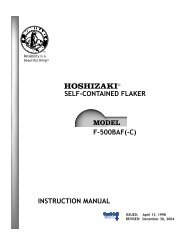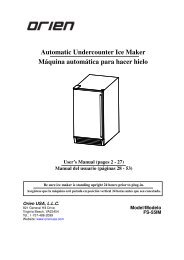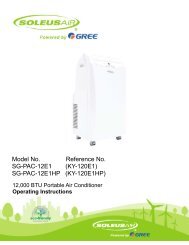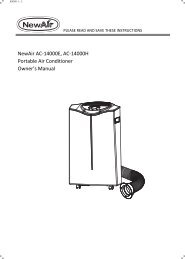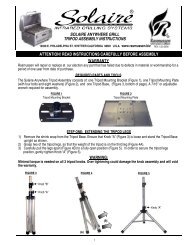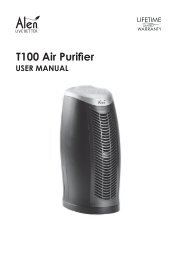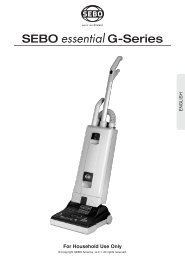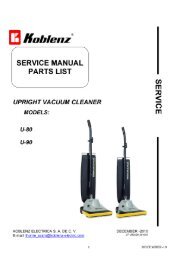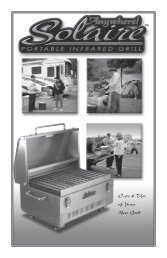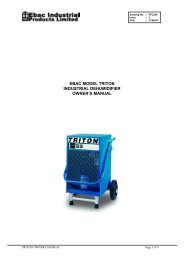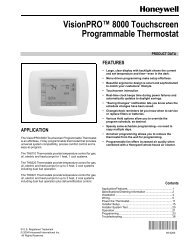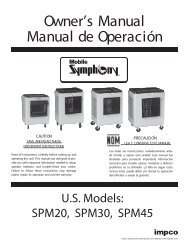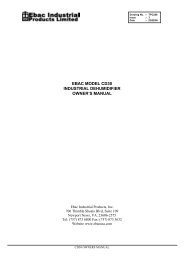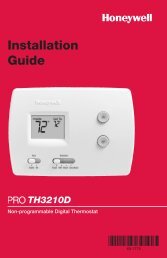68-0133 - Y8610U Intermittent Pilot Retrofit Kit - Air & Water
68-0133 - Y8610U Intermittent Pilot Retrofit Kit - Air & Water
68-0133 - Y8610U Intermittent Pilot Retrofit Kit - Air & Water
You also want an ePaper? Increase the reach of your titles
YUMPU automatically turns print PDFs into web optimized ePapers that Google loves.
<strong>Y8610U</strong> INTERMITTENT PILOT RETROFIT KIT<br />
Perform the Preinstallation Safety Inspection<br />
The preinstallation checks described in ANSI Standard<br />
Z21.71 in the ANSI Standards section must be performed<br />
before installing the Y8610. If an unsafe condition is detected,<br />
the appliance should be shut off and the owner advised of the<br />
unsafe condition. Any potentially unsafe condition must be<br />
corrected before proceeding with the Installation.<br />
Maintenance Requirements in Severe Environments<br />
Regular preventive maintenance is important in any<br />
application, but especially in commercial cooking, agricultural,<br />
and industrial applications because:<br />
• In these applications the equipment operates 100,000 to<br />
200,000 cycles per year. Such heavy cycling can wear out<br />
the gas control in one to two years. A normal forced air<br />
furnace (the original application for the controls) typically<br />
operates less than 20,000 cycles per year.<br />
• Exposure to water, dirt, chemicals, and heat can damage<br />
the module or the gas control and shut down the control<br />
system. A NEMA 4 enclosure can reduce exposure to<br />
environmental contaminants. See Electronic Ignition<br />
Service Manual, form 70-6604.<br />
The maintenance program should include regular system<br />
checkout as outlined in the Checkout section.<br />
<strong>68</strong>-<strong>0133</strong>—2<br />
WARNING<br />
FIRE OR EXPLOSION HAZARD<br />
CAN CAUSE PROPERTY DAMAGE,<br />
SEVERE INJURY, OR DEATH.<br />
Do not attempt to disassemble or clean the module.<br />
Improper reassembly and cleaning can cause<br />
unreliable operation.<br />
Maintenance frequency must be determined individually for<br />
each application based on:<br />
• Cycling frequency: Appliances that cycle more than 20,000<br />
times annually should be checked monthly.<br />
• <strong>Intermittent</strong> use: Appliances that are used seasonally<br />
should be checked before shutdown and again before the<br />
next use.<br />
• Consequence of unexpected shutdown: Where the cost of<br />
an unexpected shutdown is high, the system should be<br />
checked more often.<br />
• Dusty, wet, or corrosive environment: Because these<br />
environments can cause the controls to deteriorate more<br />
rapidly, the system should be checked more often.<br />
Any control should be replaced if it does not perform properly<br />
during Checkout or Troubleshooting. In addition, replace any<br />
module if it is wet or looks like it has been wet. Protective<br />
enclosures, see Planning the Installation, are recommended<br />
regardless of checkout frequency.<br />
Shut Down Appliance<br />
Turn off the gas supply at the appliance service valve.<br />
Do not use the gas control knob.<br />
Turn off the electricity at the service entrance.<br />
Check Appliance Wiring<br />
The standing pilot gas control wires are used with the Y8610<br />
kit. Carefully identify and tag the wires before disconnecting.<br />
See Fig. 5 for the most common types of terminal<br />
arrangements.<br />
6<br />
TO<br />
TRANSFORMER<br />
TO<br />
TRANSFORMER<br />
TO<br />
TRANSFORMER<br />
COMMON<br />
COMMON<br />
TO<br />
THERMOSTAT<br />
TO<br />
THERMOSTAT<br />
TO<br />
THERMOSTAT<br />
M<strong>68</strong>58<br />
Fig. 5. Wiring connections on standing pilot gas controls.<br />
Remove Standing <strong>Pilot</strong> Gas Control<br />
If the gas control has a common terminal(s), remove<br />
the wires connected to the common terminal(s) and<br />
splice together with one of the wire nuts provided.<br />
Label and remove the remaining wires.<br />
WARNING<br />
Do not bend the pilot gas tubing at the gas control or<br />
at the pilot burner to prevent gas leakage at the<br />
connection.<br />
Disconnect the pilot tubing at the gas control. Cut off<br />
and discard the compression fitting. Do not disturb the<br />
compression fitting or pilot tubing at the pilot burner.<br />
Disconnect the thermocouple lead at the gas control.<br />
Disconnect the gas piping at the gas control.<br />
Discard the gas control.<br />
Remove Thermocouple<br />
Unscrew or snap the thermocouple out of the pilot burner and<br />
discard. See Fig. 6.<br />
NOTE: It could be necessary to pull out the main burner for<br />
access to the pilot burner. Do not move or relocate the<br />
pilot burner. Do not bend tubing near the pilot burner.<br />
PILOT<br />
BURNER<br />
PILOT<br />
TUBING<br />
REMOVE<br />
THERMOCOUPLE<br />
M<strong>68</strong>62<br />
Fig. 6. Remove thermocouple from pilot burner.



